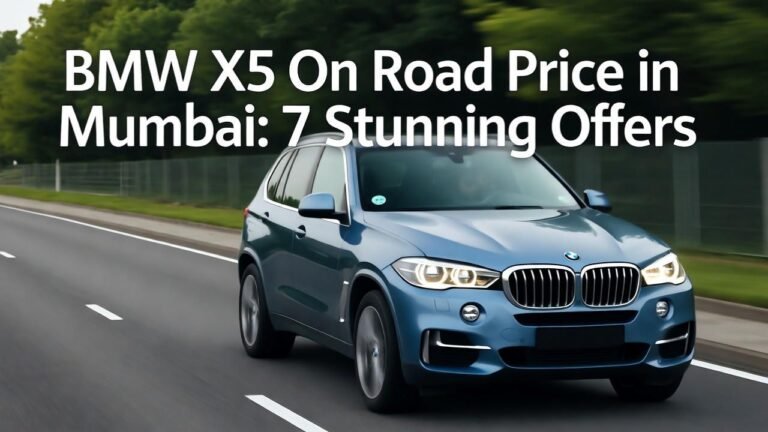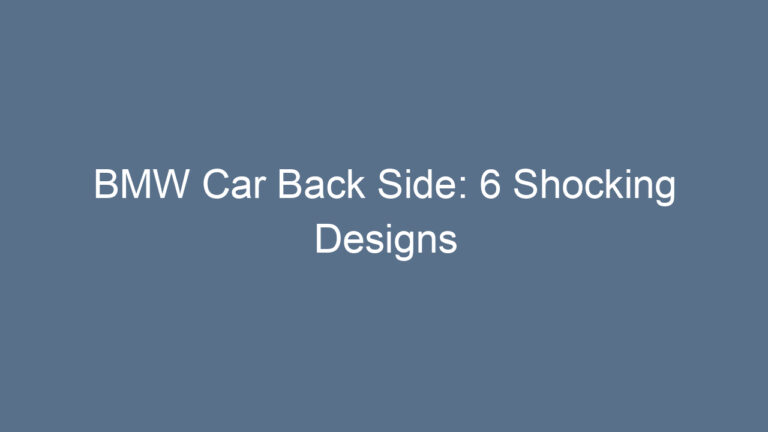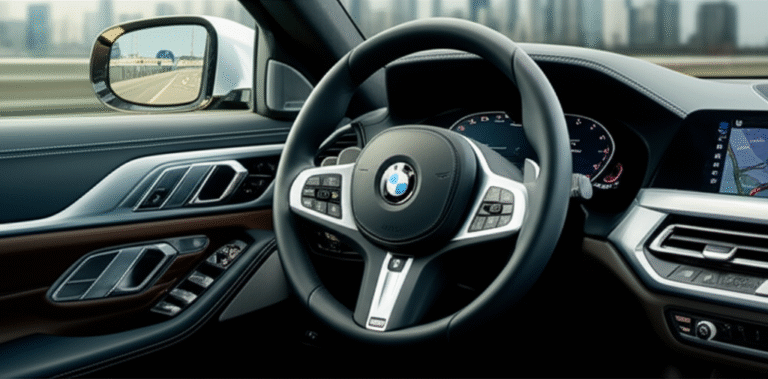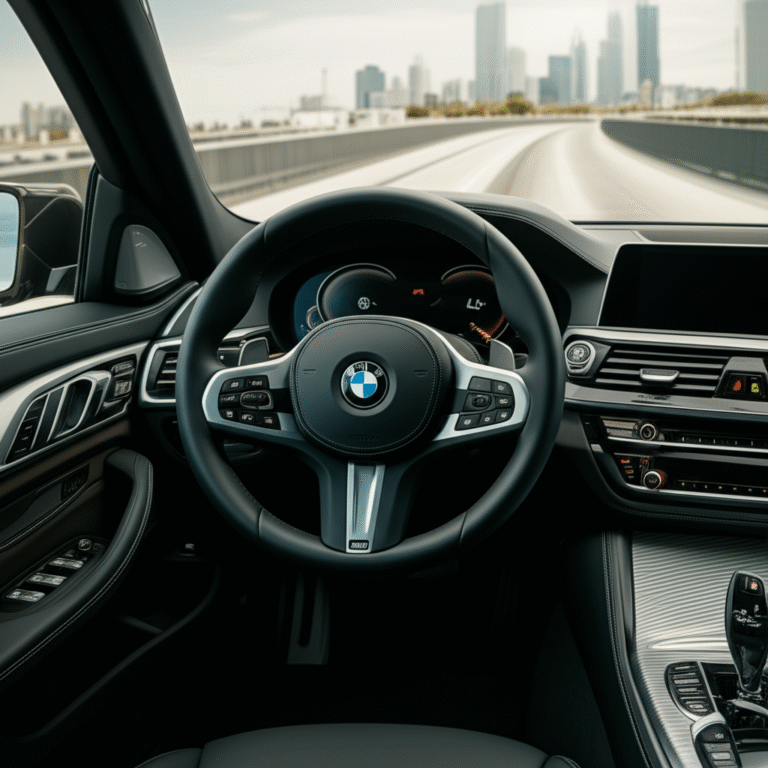BMW X1 vs X3: 6 Comparison Facts

Choosing between the BMW X1 and X3 is a common dilemma for many luxury SUV buyers in the USA. Both offer premium comfort and performance, but they cater to slightly different needs. This guide breaks down the key differences to help you make the right choice for your lifestyle.
Key Takeaways
- Compare BMW X1 vs X3 for size and space.
- Evaluate performance and driving dynamics of X1 and X3.
- Analyze interior features and technology in both models.
- Understand pricing and value for your investment.
- Consider cargo capacity and practicality for daily use.
- Learn about fuel efficiency and running costs.
Deciding on a new BMW can be exciting, especially when looking at the popular X series. You’ve likely seen both the BMW X1 and X3 on American roads, and you might be wondering about the real differences. It’s not always clear at first glance, as both are compact to mid-size luxury SUVs with that signature BMW driving feel. But they are designed with distinct purposes in mind. We’ll walk you through the essential comparison points, making it easy for you to understand which one aligns best with your driving needs and lifestyle here in the States. Let’s dive into the BMW X1 vs X3: 6 exciting comparison facts revealed.
Fact 1: Size and Dimensions – Space Matters
One of the most significant distinctions between the BMW X1 and X3 lies in their physical size and the resulting interior and cargo space. This is often the deciding factor for many buyers. Understanding these differences helps you visualize how each vehicle will fit into your daily life, whether it’s navigating busy city streets in New York or embarking on a road trip across the vast landscapes of the USA.
The BMW X1 is BMW’s smallest SUV, often categorized as a subcompact luxury crossover. It’s built on a front-wheel-drive platform (though all-wheel-drive, xDrive, is available), which allows for a more efficient use of interior space relative to its exterior footprint. This makes it nimble to drive and easy to park, a definite plus in urban environments across the country.
In contrast, the BMW X3 is a compact luxury crossover, larger than the X1. It’s built on a rear-wheel-drive platform (with xDrive all-wheel-drive standard on most trims), giving it a sportier stance and, crucially, more interior room. This extra space translates to more comfortable seating for rear passengers and a generally more substantial feel on the road.
Let’s look at some key dimensions:
| Dimension | BMW X1 (Approximate) | BMW X3 (Approximate) |
|---|---|---|
| Overall Length | 179.8 inches | 185.9 inches |
| Overall Width | 72.7 inches | 74.4 inches |
| Overall Height | 65.6 inches | 66.0 inches |
| Wheelbase | 105.1 inches | 112.8 inches |
| Front Headroom | 41.1 inches | 41.1 inches |
| Rear Headroom | 39.3 inches | 38.5 inches |
| Front Legroom | 40.4 inches | 41.4 inches |
| Rear Legroom | 37.3 inches | 36.4 inches |
As you can see, the X3 is noticeably longer and wider, with a significantly longer wheelbase. This translates directly into more passenger space, particularly for rear passengers. If you frequently carry adults in the back seat or have older children, the X3 will likely offer superior comfort. The X1, while offering respectable rear legroom for its class, can feel a bit more snug for longer journeys.
Fact 2: Performance and Driving Dynamics – The BMW Experience
BMW has built its reputation on creating vehicles that are exhilarating to drive, and both the X1 and X3 uphold this legacy, albeit with different approaches. The choice here depends on whether you prioritize agility and a more car-like feel or a more commanding presence and potent power delivery.
The BMW X1, especially in its current generation, offers a surprisingly engaging driving experience. Its smaller size and lighter weight contribute to sharper handling and a more playful character. It’s often praised for its maneuverability and how easily it navigates tight turns. Engine options typically include efficient turbocharged four-cylinder engines that provide ample power for everyday driving and spirited acceleration. For those living in or frequently visiting cities like San Francisco or Chicago, the X1’s compact nature and responsive steering make it a joy to pilot through busy streets.
The BMW X3, being larger and positioned slightly higher in BMW’s lineup, offers a more refined and robust performance. While still very capable and enjoyable on a winding road, its driving dynamics lean more towards comfortable cruising and confident highway driving. The X3 often comes with more powerful engine options, including potent turbocharged four-cylinders and more powerful turbocharged inline-six engines in M Performance variants. This extra power, combined with its longer wheelbase, contributes to a smoother, more stable ride, especially at higher speeds, making it ideal for cross-country drives or navigating the varied terrain across the USA.
Here’s a general overview of typical powertrain options:
- BMW X1: Usually powered by a turbocharged 2.0-liter inline-4 engine. It offers a good balance of performance and efficiency, suitable for most drivers. Available with front-wheel drive or BMW’s xDrive all-wheel-drive system.
- BMW X3: Typically offered with a more potent turbocharged 2.0-liter inline-4 engine as standard. Higher trims or optional packages often include a more powerful turbocharged inline-6 engine, providing a significant boost in acceleration and overall performance. xDrive all-wheel-drive is often standard.
For those who enjoy a more connected-to-the-road feel and a lighter, more agile chassis, the X1 might be the more appealing choice. If you prefer a bit more power under the hood, a smoother ride, and a more substantial feel, the X3 is likely the better fit.
Fact 3: Interior Features and Technology – Premium Comforts
Both BMW models are renowned for their upscale interiors, packed with advanced technology and high-quality materials. The primary difference lies in the execution and the level of sophistication, with the X3 generally offering a more premium experience befitting its larger size and higher segment position.
Inside the BMW X1, you’ll find a modern and driver-focused cabin. Despite its smaller exterior, BMW has managed to create a surprisingly spacious and well-appointed interior. Quality materials, intuitive ergonomics, and the latest BMW iDrive infotainment system are standard. You can expect features like a digital instrument cluster, a high-resolution central touchscreen display, smartphone integration (Apple CarPlay and Android Auto), and available premium sound systems. The design is clean, functional, and undeniably BMW.
Stepping into the BMW X3, you’ll notice an immediate sense of increased spaciousness and a more luxurious ambiance. The materials might feel a step up, with more refined trim options and a generally more substantial fit and finish. The technology suite is also often more advanced, with larger screen options for the infotainment system and instrument cluster, more available driver-assistance features, and potentially more comfort-oriented options like ventilated seats or a panoramic sunroof that feels more expansive due to the increased cabin size.
Key technology and comfort features to consider:
- Infotainment System: Both feature BMW’s iDrive system, which is lauded for its user-friendliness. The X3 may offer larger screen sizes and more advanced interface options.
- Digital Displays: Expect customizable digital instrument clusters and touchscreens in both. The X3 might offer more integrated digital experiences or higher-resolution displays.
- Connectivity: Standard smartphone integration (Apple CarPlay, Android Auto) is common in both. Wireless charging is often available.
- Driver Assistance: Both vehicles offer a suite of advanced driver-assistance systems (ADAS), such as adaptive cruise control, lane-keeping assist, and blind-spot monitoring. The X3 may offer a wider array of these systems as standard or available options.
- Comfort: Heated seats are common. The X3 often offers more premium options like ventilated seats, heated steering wheel, and enhanced ambient lighting.
For individuals or couples, the X1’s interior is more than adequate and offers a modern, tech-filled environment. However, if you frequently have passengers, appreciate a bit more luxury, or desire the latest and greatest in automotive tech, the X3 presents a more compelling package.
Fact 4: Cargo Capacity and Practicality – Daily Life Awaits
When it comes to practicality, especially for those living an active lifestyle or needing to haul gear, cargo space is a critical consideration. Here, the larger dimensions of the BMW X3 clearly give it an advantage over the X1. This difference can significantly impact your ability to manage everyday tasks, weekend getaways, or even larger shopping trips.
The BMW X1, while compact, offers a decent amount of cargo space for its class. The rear seats typically fold down, expanding the load area for larger items. It’s well-suited for groceries, luggage for a weekend trip, or sporting equipment for one or two people. The cargo opening is reasonably wide, and the load floor is flat, making it easy to load and unload.
The BMW X3 provides a more substantial cargo area, typical of a compact SUV. The longer body and wheelbase translate directly into more cubic feet of storage space behind the rear seats and with the rear seats folded down. This makes it a more practical choice for families, those who regularly carry larger items, or anyone who values maximum utility from their vehicle. The rear seats in the X3 usually offer a 40/20/40 split-folding configuration, offering more flexibility than a traditional 60/40 split for carrying passengers and cargo simultaneously.
Let’s compare the cargo volumes:
| Cargo Area | BMW X1 (Approximate) | BMW X3 (Approximate) |
|---|---|---|
| Behind Rear Seats | 25.7 cubic feet | 28.7 cubic feet |
| With Rear Seats Folded | 56.4 cubic feet | 62.7 cubic feet |
The X3 consistently offers more cargo volume in both configurations. This means you can fit more suitcases for a family vacation to national parks like Yosemite or handle larger IKEA hauls with greater ease. For everyday practicality, the X1 is competent, but the X3 offers a significant upgrade for those who need more space for their gear, hobbies, or family needs.
Fact 5: Pricing and Value – Investment Considerations
When comparing the BMW X1 and X3, one of the most straightforward differentiators is their price point. Generally, the X1, being the smaller and entry-level model, comes with a more accessible starting price, making it an attractive option for those looking to enter the BMW brand without the highest possible investment. The X3, positioned as a larger and more premium offering, naturally commands a higher price across its trim levels.
The pricing will vary based on model year, specific trim levels, optional packages, and current market conditions here in the USA. However, the X1 typically starts at a lower MSRP than the X3. This price difference can be significant, potentially allowing buyers to afford a more highly optioned X1 for the same price as a base or mid-range X3.
When considering value, it’s not just about the initial purchase price. You should also think about long-term ownership costs, including fuel efficiency, maintenance, and depreciation. BMWs generally hold their value well, but the specific figures can vary between models.
Here’s a general pricing comparison:
- BMW X1: Often positioned as the most affordable SUV in BMW’s lineup, making it a gateway to luxury SUV ownership. It offers a strong value proposition for its size and feature set.
- BMW X3: Priced higher, reflecting its larger size, more powerful standard engines (in many configurations), and typically more premium standard features. It offers a more substantial luxury experience for the increased cost.
For budget-conscious buyers or those who don’t need the extra space or power of the X3, the X1 presents a compelling value. You get the BMW badge, the driving dynamics, and the premium interior at a more attainable price. However, if your budget allows and you desire the added space, refinement, and performance, the X3 represents excellent value within the compact luxury SUV segment, offering a more complete package for those who can justify the higher cost.
Fact 6: Fuel Efficiency and Running Costs – Keeping You Moving
For many drivers in the USA, fuel efficiency and the associated running costs are critical factors in their vehicle purchasing decision. While both the X1 and X3 are designed with a balance of performance and efficiency, there are typically differences in their fuel economy ratings that correspond with their size, weight, and powertrain options. Understanding these differences can help you estimate your ongoing expenses.
The BMW X1, due to its smaller size, lighter weight, and often more fuel-efficient base engine, generally achieves better miles per gallon (MPG). Its front-wheel-drive architecture (on non-xDrive models) can also contribute to slightly better efficiency. This makes it a more economical choice for daily commuting, especially in areas with higher fuel prices or for drivers who cover significant distances regularly.
The BMW X3, being larger and heavier, and often equipped with more powerful standard engines (especially the inline-6 options), typically has slightly lower MPG ratings. However, BMW continuously works to improve the efficiency of its powertrains through advanced technologies like turbocharging and efficient transmissions. The gap in fuel economy between the two models might not be enormous, especially when comparing similar engine configurations and drive types (e.g., X1 xDrive vs. X3 xDrive with the 4-cylinder engine), but the X1 usually holds a slight edge.
Here’s a general outlook on fuel economy (EPA estimates can vary by year and specific configuration):
- BMW X1: Expect generally higher MPG figures, making it more efficient for daily driving and long-distance cruising.
- BMW X3: While still efficient for its class, it typically offers slightly lower MPG than the X1, especially with the more powerful engine options.
When considering running costs beyond fuel, other factors include insurance premiums, maintenance schedules, and potential repair costs. While both are premium vehicles, the X1 might have slightly lower insurance rates due to its lower entry price and smaller size. Maintenance costs for BMWs can be higher than non-luxury brands, but sticking to the recommended service schedules, which you can often find through resources like BMW USA’s ownership portal, is crucial for longevity and performance. For the most up-to-date information on fuel economy for specific models and trims, always refer to the official EPA ratings and manufacturer specifications.
BMW X1 vs. X3: Pros and Cons
To summarize the comparison, here’s a quick look at the advantages and disadvantages of each model:
BMW X1
- Pros: More affordable purchase price, nimbler handling, easier to maneuver in tight spaces, generally better fuel economy.
- Cons: Less rear passenger space, smaller cargo capacity, potentially fewer standard luxury features in base trims.
BMW X3
- Pros: More spacious interior and cargo area, more powerful engine options available, more luxurious feel, smoother ride.
- Cons: Higher purchase price, can feel less agile than the X1, generally lower fuel economy.
Which BMW Is Right for You? A Final Thought
Choosing between the BMW X1 and X3 ultimately boils down to your individual priorities and lifestyle. If you’re a city dweller, a solo driver, a couple, or someone who values agility and affordability in a premium package, the BMW X1 is an excellent choice. It delivers the core BMW experience in a compact, efficient, and fun-to-drive SUV that’s perfect for navigating American streets and embracing urban living.
On the other hand, if you need more space for family, friends, or gear; if you frequently embark on longer road trips across the USA; or if you simply desire a more commanding presence and a more luxurious interior, the BMW X3 is the clear winner. It offers a more substantial SUV experience with greater comfort, capability, and available power, all while maintaining BMW’s signature driving dynamics.
Consider test-driving both models back-to-back. Pay attention to how each one feels to you on the road, how the interior space accommodates your needs, and how the technology interfaces work for your preferences. Your perfect BMW is out there, and understanding these key differences will get you closer to finding it.
Frequently Asked Questions: BMW X1 vs X3
Q1: Which BMW SUV is better for families, the X1 or X3?
The BMW X3 is generally better for families due to its larger interior, more comfortable rear seating, and significantly bigger cargo capacity. This makes it easier to accommodate children, car seats, strollers, and all the gear that comes with family life.
Q2: Is the BMW X1 considered a luxury vehicle?
Yes, the BMW X1 is considered a luxury compact SUV. It offers premium materials, advanced technology, and the performance expected from the BMW brand at a more accessible price point.
Q3: How does the all-wheel-drive system (xDrive) differ between the X1 and X3?
Both models offer BMW’s xDrive all-wheel-drive system, which is designed to enhance traction and stability. While the core technology is similar, the X3’s system may be integrated with a more robust drivetrain and suspension setup, befitting its larger and more performance-oriented platform.
Q4: Which model is more engaging to drive, the X1 or X3?
The BMW X1 is often considered more engaging and agile due to its smaller size and lighter weight, offering a more nimble and playful driving experience. The X3 is also very engaging but leans more towards refined cruising and confident highway stability.
Q5: Are both the X1 and X3 available with manual transmissions?
In the USA, both the BMW X1 and X3 are exclusively offered with automatic transmissions (typically an 8-speed Steptronic automatic) in recent model years. Manual transmissions are no longer available for these models in the American market.
Q6: Which BMW model offers more advanced safety features?
Both models offer a comprehensive suite of advanced safety and driver-assistance features. However, the X3, being a higher-tier model, may offer a wider array of these features as standard or have more sophisticated versions available, such as enhanced adaptive cruise control systems or more advanced parking aids.
Q7: Can I tow with the BMW X1 or X3?
Towing capabilities vary significantly by model and year. While some configurations of the BMW X3 are rated for towing (check specific model specifications and local towing laws, which are regulated by agencies like the National Highway Traffic Safety Administration (NHTSA)), the BMW X1 is generally not designed or recommended for towing substantial loads.
Selecting the right BMW luxury SUV is a personal journey, and understanding the distinct characteristics of the X1 and X3 is the first step. Whether you prioritize maneuverability and value with the X1, or space and enhanced luxury with the X3, you’re choosing a vehicle that embodies German engineering and a passion for driving. Both are excellent choices for navigating the diverse landscapes and lifestyles across the United States, offering a premium experience tailored to different needs.






